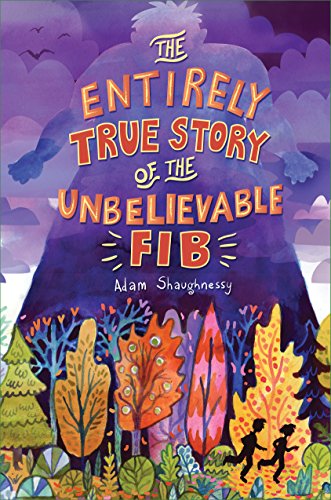Love middle grade fiction? This post is for you! Not sure about middle-grade fiction? This post is for you too!
Adam Shaughnessy’s enthusiasm for middle-grade fiction is contagious, and we hope Books in Bloom readers are inspired to read and share more fantastic stories written for middle-grade audiences after reading this post from Adam.
Enjoy!
—
A few months ago I learned something that inspired me to perform backflips—well, not literal backflips, obviously. Backflips are really hard (and I’m spectacularly uncoordinated). But I did figurative backflips, and lots of them. What spurred this exhibition of not-actual acrobatics? I learned that my publisher was planning an iLoveMG promotion to celebrate middle-grade books for children.
I was thrilled. Middle-grade books are wonderful. They’re important. And they deserve to be celebrated for a great many reasons.
 I should preface what follows with an admission: I’m biased. Even before the first novel I wrote, The Entirely True Story of the Unbelievable FIB, was published, I loved middle-grade fiction and advocated for it wherever I could. In fact, I went so far as to create a brand of children’s enrichment programming for young people in the intermediate grades because I believed (and still believe) that stories are especially impactful for girls and boys of those ages. So while I acknowledge (grudgingly!) that all books are special and that people form meaningful connections with books at every age, deep down I remain convinced that there is something uniquely powerful and delightful about middle-grade literature. Here’s why.
I should preface what follows with an admission: I’m biased. Even before the first novel I wrote, The Entirely True Story of the Unbelievable FIB, was published, I loved middle-grade fiction and advocated for it wherever I could. In fact, I went so far as to create a brand of children’s enrichment programming for young people in the intermediate grades because I believed (and still believe) that stories are especially impactful for girls and boys of those ages. So while I acknowledge (grudgingly!) that all books are special and that people form meaningful connections with books at every age, deep down I remain convinced that there is something uniquely powerful and delightful about middle-grade literature. Here’s why.
To begin, I think it has something to do with the ages of the children who read middle grade. I was a second and third-grade teacher for a number of years (and did extensive work with fourth and fifth graders, too) so I know first hand what an extraordinary period that is for children. Every new stage of child development can be likened to a journey, but none of the other journeys can claim to be so fantastic as the one children experience as they enter the middle grade years.
Just consider the convergence of events in children’s lives at that stage! They’re leaving behind the egocentrism of their younger years and learning to explore (awkwardly, at times) the world through others’ eyes and perspectives. At the same time they’re spreading the wings of their emerging fluency and their imaginations are taking flight through worlds of books that are newly available to them. In many ways, they’re experiencing an infinite expansion of horizons. They’re not just discovering this world. They’re discovering whole new universes! And middle-grade books are the vehicles that are taking them on that journey of exploration.
But there’s something else, something more, that makes middle-grade books so special. They’re playful.
That makes sense, I suppose. Adults (generally) accept play as part of the childhood experience. We consider playing to be essential to child development because it contributes to the cognitive, physical, social, and emotional well-being of young people. Perhaps that’s why picture books and middle-grade books possess an element of playfulness in greater quantity than books for teens and adults. But while picture books can also (undeniably) make a claim to playfulness, I think that it’s at the middle-grade level that the concept of play within a story fully manifests.
The middle-grade ages are a time when children experience a growth in their play—it evolves from free play to more elaborate constructions and interactions. When I was a teacher, I loved observing the sophisticated fantasy play that developed on the playground at recess. Hodge-podge adventures that blended books, comics, television, movies, and other unnamable and unknowable sources carried my students through time, across exotic landscapes, and through lost and forgotten temples that only bore a passing similarity to the climbing structures that occupied the playground. The influence of story on my students’ play was unmistakable, and over time I grew to appreciate how much that sense of playfulness was likewise reflected in the stories themselves, particularly in middle-grade books.
I marveled at that intersection of story and play. It planted the seeds for much of the work I would do, both as a writer and an educator, for the next twenty years. It solidified one of my core beliefs: that story and play are two of the most effective tools that young people have to make sense of their world. Stories introduce children to new roles and concepts. Play allows children to explore those roles and concepts in a concrete way. Together, story and play are immensely powerful forces—and they achieve their full potential in middle-grade books, I think.
.Middle grade books are magical. They’re mysterious. They suggest possible routes through the ever-expanding landscapes of childhood and all the challenges, rewards, and weirdness that those journeys can present. More than that, though, and most important to me, they embody the playfulness of the age they represent.
And it is playfulness, not innocence or simplicity. Middle-grade literature is no less capable of complexity or depth of emotion than the young people for whom it is written. But middle-grade fiction has permission, perhaps by virtue of its audience, of addressing concepts and complexities in a way that’s unhindered by the cynicism that we seem to expect from and for the adult world.
Perhaps that’s why I never hesitated when it came time to determine an audience for my first book. My greatest hope is that my books will be playgrounds for the imaginations of my readers. I want to be a part of that wild, magnificent intersection of story and play.
In the end, that’s why I always have, and always will love middle grade.
—
From the Publisher

Adam Shaughnessy (c) Angela Chicoski Photography
About the Author: Adam Shaughnessy is an author and educator. He received his BA in English from Connecticut College and is currently pursuing his MA in children’s literature from Hollins University. Adam lives in Waterford, Connecticut.
About the Book: Strange things are happening in Middleton. Dark clouds have gathered over the sleepy New England community and something big is lurking in the woods around the town. Fortunately, eleven-year-old Prudence Potts is on the case—and she’s dragging the new boy in her class, ABE, along for the ride. But when Pru’s keen detective skills and ABE’s talent for solving riddles lead them to the mysterious Mister Fox, the two unlikely heroes discover some shocking truths. They learn that magic is real, talking squirrels are rude, and that giants from Norse mythology are about to trample Middleton in their search for a lost Viking artifact! It’s up to Pru and her new friends to stop the giants and save Middleton—and maybe the world. To do that, though, Pru will first have to answer one all-important question: “WHAT IS THE UNBELIEVABLE FIB?”






